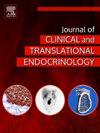CuPeR模型:预测垂体手术后库欣病持续和复发的动态在线工具
IF 3.3
Q1 ENDOCRINOLOGY & METABOLISM
Journal of Clinical and Translational Endocrinology
Pub Date : 2025-08-27
DOI:10.1016/j.jcte.2025.100417
引用次数: 0
摘要
目的预测库欣病(CD)术后的持续和复发仍然是一个临床挑战,目前还没有普遍可靠的模型。本研究引入了CuPeR模型,这是一种在线动态图,旨在通过预测接受垂体手术的CD患者的术后结果来解决这些差距。方法对2010 ~ 2024年间211例CD患者进行回顾性队列分析。主要患者和肿瘤特征、影像学表现和治疗细节进行了评估。多变量logistic回归确定了CD术后持续或复发的独立预测因素(PoRP-CD),然后根据赤池信息标准逐步选择将其纳入CuPeR模型。使用测试数据集进行内部验证,并开发了一个用户友好的在线nomogram,以促进临床实践中对患者特定风险的即时评估。结果最终的预测模型确定了四个关键因素:症状持续时间、MRI Hardy分级、肿瘤部位和既往垂体手术。较长的症状持续时间和既往手术史显著增加了复发的风险,而双侧肿瘤位置降低了这种风险。该模型的受试者工作特征曲线下面积(AUC-ROC)为0.70,准确率为83%,特异性为96%,灵敏度为33%。结论CuPeR模型可作为预测PoRP-CD的实用工具,通过提供个性化的风险评估来加强术前决策。本文章由计算机程序翻译,如有差异,请以英文原文为准。
The CuPeR model: A dynamic online tool for predicting Cushing’s disease persistence and recurrence after pituitary surgery
Objective
Predicting postoperative persistence and recurrence of Cushing’s disease (CD) remains a clinical challenge, with no universally reliable models available. This study introduces the CuPeR model, an online dynamic nomogram developed to address these gaps by predicting postoperative outcomes in patients with CD undergoing pituitary surgery.
Methods
A retrospective cohort of 211 patients treated for CD between 2010 and 2024 was analyzed. Key patient and tumor characteristics, imaging findings, and treatment details were evaluated. Multivariate logistic regression identified independent predictors of postoperative persistence or recurrence of CD (PoRP-CD), which were then incorporated into the CuPeR model using stepwise selection based on Akaike Information Criterion. Internal validation was performed using a testing dataset, and a user-friendly online nomogram was developed to facilitate immediate, patient-specific risk estimation in clinical practice.
Results
The final predictive model identified four key factors: symptom duration, MRI Hardy’s grade, tumor site, and prior pituitary surgery. Longer symptom duration and a history of prior surgery significantly increased the risk of recurrence, while bilateral tumor location reduced this risk. The model demonstrated an area under the receiver operating characteristic curve (AUC-ROC) of 0.70, with 83% accuracy, specificity of 96%, and sensitivity of 33%.
Conclusions
The CuPeR model may offer a practical tool for predicting PoRP-CD, enhancing preoperative decision-making by providing personalized risk assessments.
求助全文
通过发布文献求助,成功后即可免费获取论文全文。
去求助
来源期刊

Journal of Clinical and Translational Endocrinology
ENDOCRINOLOGY & METABOLISM-
CiteScore
6.10
自引率
0.00%
发文量
24
审稿时长
16 weeks
 求助内容:
求助内容: 应助结果提醒方式:
应助结果提醒方式:


